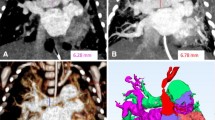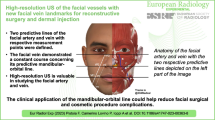Abstract
The effect of percutaneous, surgical, and medical therapies for vascular malformations (VMs) is often difficult to quantify volumetrically using cross-sectional imaging. Volumetric measurement is often estimated with serial, expensive MRI examinations which may require sedation or anesthesia. We aim to explore whether a portable 3D scanning device is capable of rapid, accurate volumetric analysis of pediatric VMs. Using an iPad-mounted infrared scanning device, 3D scans of patient faces, arms, and legs were acquired over an 8-month study period. Proprietary software was use to perform subsequent volumetric analysis. Of a total of 30 unilateral VMs involving either the face, arms, or legs, 26 (86.7%) VMs were correctly localized by discerning the larger volume of the affected side compared to the normal contralateral side. For patients with unilateral facial VMs (n = 10), volume discrepancy between normal and affected sides differed compared with normal controls (n = 19). This was true for both absolute (60 cc ± 55 vs 15 cc ± 8, p = 0.03) as well as relative (18.1% ± 13.2 vs 4.0% ± 2.1, p = 0.008) volume discrepancy. Following treatment, two patients experienced change in leg volume discrepancy ranging from − 17.3 to − 0.4%. Using a portable 3D scanning device, we were able to rapidly and noninvasively detect and quantify volume discrepancy resulting from VMs of the face, arms, and legs. Preliminary data suggests this technology can detect volume reduction of VMs in response to therapy.






Similar content being viewed by others
References
Buckmiller LM, Richter GT, Suen JY: Diagnosis and management of hemangiomas and vascular malformations of the head and neck. Oral Dis. 16(5):405–418, 2010
Alexander MD, McTaggart RA, Choudhri OA et al.: Quantitative volumetric analysis of head and neck venous and lymphatic malformations to assess response to percutaneous sclerotherapy. Acta Radiol. 57(2):205–209, 2016
Caty V, Kauffmann C, Dubois J, Mansour A, Giroux MF, Oliva V, Piché N, Therasse E, Soulez G: Clinical validation of semi-automated software for volumetric and dynamic contrast enhancement analysis of soft tissue venous malformations on magnetic resonance imaging examination. Eur Radiol. 24(2):542–551, 2014
Kirkham EM, Edwards TC, Weaver EM, Balakrishnan K, Perkins JA: The lymphatic malformation function (LMF) instrument. Otolaryngol Head Neck Surg. 153(4):656–662, 2015
Harrison JA, Nixon MA, Fright WR, Snape L: Use of hand-held laser scanning in the assessment of facial swelling: a preliminary study. Br J Oral Maxillofac Surg. 42(1):8–17, 2004
Kau CH, Cronin AJ, Richmond S: A three-dimensional evaluation of postoperative swelling following orthognathic surgery at 6 months. Plast Reconstr Surg. 119(7):2192–2199, 2007
van der Meer WJ, Dijkstra PU, Visser A, Vissink A, Ren Y: Reliability and validity of measurements of facial swelling with a stereophotogrammetry optical three-dimensional scanner. Br J Oral Maxillofac Surg. 52(10):922–927, 2014
Hameeteman M, Verhulst AC, Vreeken RD, Maal TJ, Ulrich DJ: 3D stereophotogrammetry in upper-extremity lymphedema: an accurate diagnostic method. J Plast Reconstr Aesthet Surg. 69(2):241–247, 2016
Cau N, Galli M, Cimolin V, Grossi A, Battarin I, Puleo G, Balzarini A, Caraceni A: Quantitative comparison between the laser scanner three-dimensional method and the circumferential method for evaluation of arm volume in patients with lymphedema. J Vasc Surg Venous Lymphat Disord. 6(1):96–103, 2018
Mestre S, Veye F, Perez-Martin A, Behar T, Triboulet J, Berron N, Demattei C, Quéré I: Validation of lower limb segmental volumetry with hand-held, self-positioning three-dimensional laser scanner against water displacement. J Vasc Surg Venous Lymphat Disord. 2(1):39–45, 2014
Yahathugoda C, Weiler MJ, Rao R, de Silva L, Dixon JB, Weerasooriya MV, Weil GJ, Budge PJ: Use of a novel portable three-dimensional imaging system to measure limb volume and circumference in patients with filarial lymphedema. Am J Trop Med Hyg. 97(6):1836–1842, 2017
Kau CH, Hartles FR, Knox J, Zhurov AI, Richmond S: Natural head posture for measuring three-dimensional soft tissue morphology. Cardiff: FIRST Numerics, 2005
Cignoni P, Callieri M, Corsini M, Dellepiane M, Ganovelli F, Ranzuglia G: Meshlab: an open-source mesh processing tool. Paper presented at: Eurographics Italian Chapter Conference, 2008.
Toma AM, Zhurov A, Playle R, Ong E, Richmond S: Reproducibility of facial soft tissue landmarks on 3D laser-scanned facial images. Orthod Craniofac Res 12(1):33–42, 2009
Knoops PG, Beaumont CA, Borghi A et al.: Comparison of three-dimensional scanner systems for craniomaxillofacial imaging. J Plast Reconstr Aesthet Surg 70(4):441–449, 2017
Berenguer B, Burrows PE, Zurakowski D, Mulliken JB: Sclerotherapy of craniofacial venous malformations: complications and results. Plast Reconstr Surg 104(1):1–11, 1999 discussion 12-15
Acknowledgments
This study would not have been possible without Victoria Allen, who assisted with coordinating IRB approval and maintaining compliance with institutional research policies.
Disclosure
M.W. is employed by LymphaTech. He and J.D. have an equity stake in the company.
Author information
Authors and Affiliations
Corresponding author
Additional information
Publisher’s Note
Springer Nature remains neutral with regard to jurisdictional claims in published maps and institutional affiliations.
Electronic Supplementary Material
Online Resource 1
a) An unaltered 3D scan of the head and neck of a control patient rendered using MeshLab. b) The scan is manually aligned using the Manipulator tool to correct for any postural deviations from natural head position. c) A duplicate scan (purple) is imported into MeshLab. d) Six points are then manually selected on facial landmarks of the duplicate scan, each point corresponding to a point selected on the previously aligned “reference scan” (pink). e) Using the Point-based Gluing Alignment tool, the duplicate scan is aligned to the reference scan by orienting the scan such that the user-selected points on each scan are placed in closest proximity to each other. (PNG 2002 kb)
Online Resource 2
a) The region of interest (red) for the face is manually identified with boundaries defined superiorly by the level of the eye, inferiorly by the chin, anteriorly by the tip of the nose, posteriorly and laterally by the anterior crease of the earlobes. b) The region of interest is then bisected to allow for volume comparison of left and right sides. The sagittal plane is created using input from a user-defined midpoint of the nose. c) A cross-sectional view of the region of interest. (PNG 3908 kb)
ESM 1
(PDF 90 kb)
Rights and permissions
About this article
Cite this article
Speir, E.J., Matthew Hawkins, C., Weiler, M.J. et al. Volumetric Assessment of Pediatric Vascular Malformations Using a Rapid, Hand-Held Three-Dimensional Imaging System. J Digit Imaging 32, 260–268 (2019). https://doi.org/10.1007/s10278-019-00183-6
Published:
Issue Date:
DOI: https://doi.org/10.1007/s10278-019-00183-6




